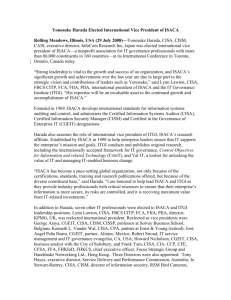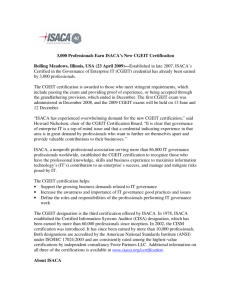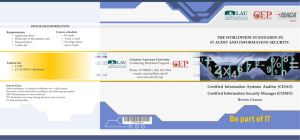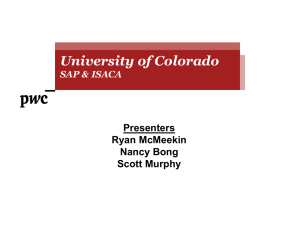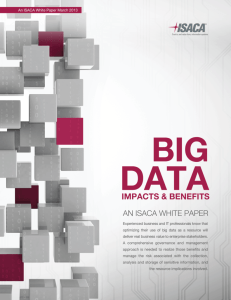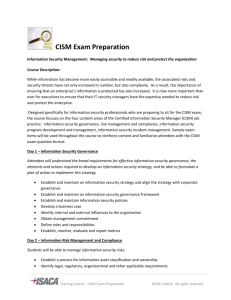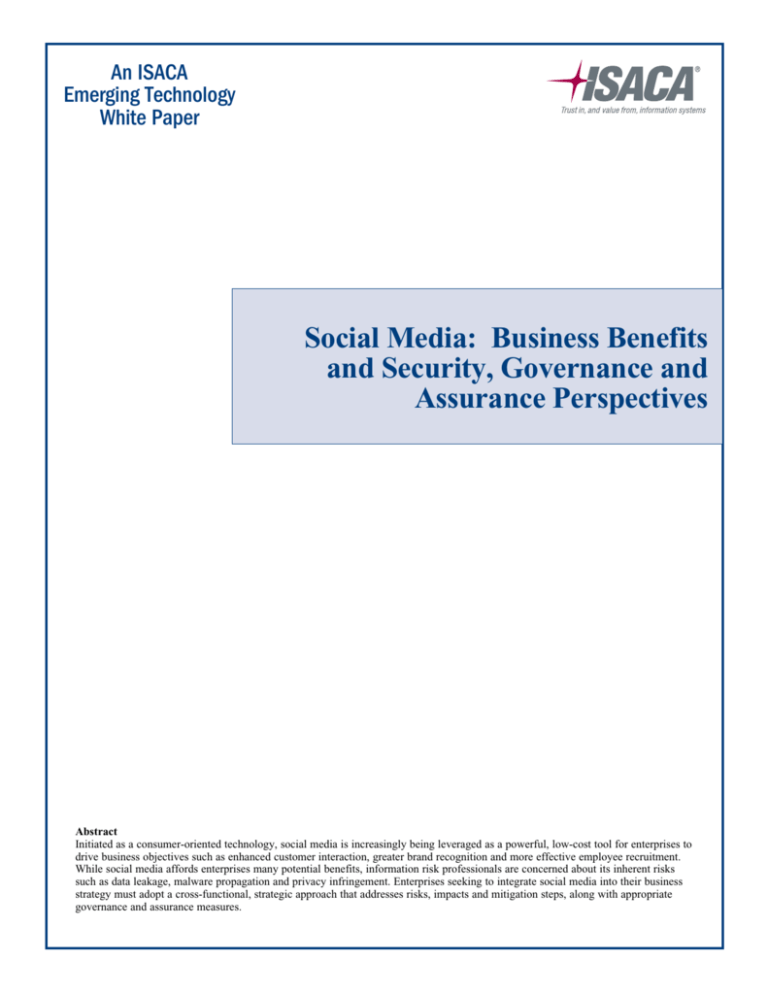
An ISACA
Emerging Technology
White Paper
Social Media: Business Benefits
and Security, Governance and
Assurance Perspectives
Abstract
Initiated as a consumer-oriented technology, social media is increasingly being leveraged as a powerful, low-cost tool for enterprises to
drive business objectives such as enhanced customer interaction, greater brand recognition and more effective employee recruitment.
While social media affords enterprises many potential benefits, information risk professionals are concerned about its inherent risks
such as data leakage, malware propagation and privacy infringement. Enterprises seeking to integrate social media into their business
strategy must adopt a cross-functional, strategic approach that addresses risks, impacts and mitigation steps, along with appropriate
governance and assurance measures.
Social Media: Business Benefits and Security, Governance
and Assurance Perspectives
ISACA®
With more than 86,000 constituents in more than 160 countries, ISACA (www.isaca.org) is a leading global provider of
knowledge, certifications, community, advocacy and education on information systems (IS) assurance and security, enterprise
governance of IT, and IT-related risk and compliance. Founded in 1969, ISACA sponsors international conferences, publishes
the ISACA® Journal, and develops international IS auditing and control standards. It also administers the globally respected
Certified Information Systems Auditor™ (CISA®), Certified Information Security Manager® (CISM®), Certified in the
Governance of Enterprise IT® (CGEIT®) and the Certified in Risk and Information Systems ControlTM (CRISCTM) designations.
ISACA offers the Business Model for Information Security (BMIS) and the IT Assurance Framework™ (ITAF™). It also
developed and maintains the CobiT®, Val IT™ and Risk IT frameworks, which help IT professionals and enterprise leaders
fulfill their IT governance responsibilities and deliver value to the business.
Disclaimer
ISACA has designed and created Social Media: Business Benefits and Security, Governance and Assurance Perspectives
(the “Work”), primarily as an educational resource for security, governance and assurance professionals. ISACA makes
no claim that use of any of the Work will assure a successful outcome. The Work should not be considered inclusive of all
proper information, procedures and tests or exclusive of other information, procedures and tests that are reasonably directed
to obtaining the same results. In determining the propriety of any specific information, procedure or test, security, governance
and assurance professionals should apply their own professional judgment to the specific control circumstances presented by
the particular systems or information technology environment.
Reservation of Rights
© 2010 ISACA. All rights reserved. No part of this publication may be used, copied, reproduced, modified, distributed,
displayed, stored in a retrieval system or transmitted in any form by any means (electronic, mechanical, photocopying,
recording or otherwise) without the prior written authorization of ISACA. Reproduction and use of all or portions of this
publication are permitted solely for academic, internal and noncommercial use and for consulting/advisory engagements, and
must include full attribution of the material’s source. No other right or permission is granted with respect to this work.
ISACA
3701 Algonquin Road, Suite 1010
Rolling Meadows, IL 60008 USA
Phone: +1.847.253.1545
Fax: +1.847.253.1443
E-mail: info@isaca.org
Web site: www.isaca.org
Social Media: Business Benefits and Security, Governance and Assurance Perspectives
CRISC is a trademark/service mark of ISACA. The mark has been applied for or registered in countries throughout the world.
2
© 2010 ISACA. A
l l
r i g h t s
r e s e r v e d
.
Social Media: Business Benefits and Security, Governance
and Assurance Perspectives
ISACA wishes to recognize:
Project Development Team
Salomon Rico, CISA, CISM, CGEIT, Deloitte, Mexico, Chair
Ben Bradley, Macon Raine Inc., USA
Michael Kiefer, BrandProtect, USA
Expert Review Team
Victor Chapella, Sm4rt Security Services, Mexico
Clyde Hague, CISM, CISSP, First Merchants Corp., USA
Peter M. Rodgers, CISA, Resources Global Professionals, USA
Jon Sternberg, CISA, CISM, CISSP, FFSI, FLMI, Northwestern Mutual, USA
Chris Tignor, CISM, CISSP, Capital One Financial, USA
ISACA Board of Directors
Emil D’Angelo, CISA, CISM, Bank of Tokyo-Mitsubishi UFJ Ltd., USA, International President
George Ataya, CISA, CISM, CGEIT, CISSP, ICT Control SA-NV, Belgium, Vice President
Yonosuke Harada, CISA, CISM, CGEIT, CAIS, InfoCom Research Inc., Japan, Vice President
Ria Lucas, CISA, CGEIT, Telstra Corp., Australia, Vice President
Jose Angel Pena Ibarra, CGEIT, Alintec, Mexico, Vice President
Robert E. Stroud, CGEIT, CA Technologies, USA, Vice President
Kenneth L. Vander Wal, CISA, CPA, Ernst & Young LLP (retired), USA, Vice President
Rolf von Roessing, CISA, CISM, CGEIT, KPMG Germany, Germany, Vice President
Lynn Lawton, CISA, FBCS CITP, FCA, FIIA, KPMG Ltd., Russia, UK, Past International President
Everett C. Johnson Jr., CPA, Deloitte & Touche LLP (retired), USA, Past International President
Gregory T. Grocholski, CISA, The Dow Chemical Co., USA, Director
Tony Hayes, CGEIT, AFCHSE, CHE, FACS, FCPA, FIIA, Queensland Government, Australia, Director
Howard Nicholson, CISA, CGEIT, City of Salisbury, Australia, Director
Jeff Spivey, CPP, PSP, Security Risk Management, USA, ITGI Trustee
Guidance and Practices Committee
Kenneth L. Vander Wal, CISA, CPA, Ernst & Young LLP (retired), USA, Chair
Phil James Lageschulte, CGEIT, CPA, KPMG LLP, USA
Mark A. Lobel, CISA, CISM, CISSP, PricewaterhouseCoopers LLP, USA
Adel H. Melek, CISA, CISM, CGEIT, Deloitte & Touche, Canada
Ravi Muthukrishnan, CISA, CISM, FCA, ISCA, Capco IT Service India Pvt Ltd., India
Anthony P. Noble, CISA, Viacom, USA
Salomon Rico, CISA, CISM, CGEIT, Deloitte, Mexico
Eddy Justin Schuermans, CISA, CGEIT, ESRAS bvba, Belgium
Frank Van Der Zwaag, CISA, CISSP, Westpac, New Zealand
© 2010 ISACA. A
l l
r i g h t s
r e s e r v e d
.
3
Social Media: Business Benefits and Security, Governance
and Assurance Perspectives
Impacts of Social Media
Gone are the days of recommendations to keep social media usage out of the enterprise. Businesses today find that social
media use is no longer the exception, but rather the rule. Business units such as research and development, marketing,
human resources, sales, and customer service are realizing the potential for utilizing social media tools to stimulate
innovation, create brand recognition, hire and retain employees, generate revenue, and improve customer satisfaction.
Social media use is no longer just an option for enterprises that want to lead in today’s business environment.
Of the Fortune Global 100
companies, 65 percent have
active Twitter accounts, 54
percent have Facebook fan
pages, 50 percent have YouTube
video channels and 33 percent
have corporate blogs.
Use of social media has even begun to impact brand recognition and
enterprise revenue. A 2009 study by ENGAGEMENTdb found that the
most valuable brands in the world are experiencing a direct correlation
between top financial performance and deep social media engagement.
Findings of the study show that enterprises that aggressively embrace
social media as part of their strategy are more financially successful.1
It is encouraging that enterprises have seen not just a return on investment
(ROI), but also revenue increases from the use of social media. But
enterprises must be cautious since there have also been negative
impacts such as liability for libel, privacy violations and damage to
brand recognition.
What Is Considered “Social Media”?
Social media technology involves the creation and dissemination of content through social networks using the Internet.
The differences between traditional and social media are defined by the level of interaction and interactivity available to
the consumer. For example, a viewer can watch a news broadcast on television with no interactive feedback mechanisms,
while social media tools allow consumers to comment, discuss and even distribute the news. Use of social media has
created highly effective communication platforms where any user, virtually anywhere in the world, can freely create
content and disseminate this information in real time to a global audience ranging in size from a handful to literally
millions—in less time than it takes to read this document.
There are many types of social media tools: blogs such as WordPress and TypePad, microblogs such as Twitter and
Tumblr, image and video sharing sites such as Flickr and YouTube, social networking sites such as Facebook and
MySpace, and professional networking sites such as LinkedIn. The common link among all forms of social media is
that the content is supplied and managed by individual users who leverage the tools and platforms provided by social
media sites.
The Business Benefits of Social Media
Enterprises that
aggressively embrace
social media as part of
their strategy are more
financially successful.
Social media has become a powerful tool for enterprises across the globe. A 2010
Burson-Marsteller study showed that, “of the Fortune Global 100 companies, 65
percent have active Twitter accounts, 54 percent have Facebook fan pages, 50
percent have YouTube video channels and 33 percent have corporate blogs.”2
NGAGEMENTdb, The World’s Most Valuable Brands. Who’s Most Engaged? Ranking the Top 100 Global Brands, www.engagementdb.com/downloads/
E
ENGAGEMENTdb_Report_2009.pdf
2
Burson-Marsteller, The Global Social Media Check-up Insights: From the Burson-Marsteller Evidence-based Communications Group, www.burson-marsteller.com/
Innovation_and_insights/blogs_and_podcasts/BM_Blog/Documents/Burson-Marsteller%202010%20Global%20Social%20Media%20Check-up%20white%20paper.pdf
1
4
© 2010 ISACA. A
l l
r i g h t s
r e s e r v e d
.
Social Media: Business Benefits and Security, Governance
and Assurance Perspectives
Enterprises are using social media in many functional areas of the business and are enjoying numerous tangible benefits
such as increasing brand recognition, sales, search engine optimization (SEO), web traffic, customer satisfaction, and
revenue.3 In addition, rapid feedback and insight from consumers provide a mechanism for executives to assess consumer
opinion and use this information to improve products, customer service and perception.
Enterprises have also discovered that they are able to monitor the market, their competition and their customers via social
media outlets. This allows engaged enterprises to be on top of any changes that may be needed and to proactively make
appropriate adjustments to strategies, products or services.
The ability to search for and communicate with potential employees is another area that has seen great enhancement via
sites such as LinkedIn and Plaxo.
Given its ease of use and measurement and its ability to reach large populations almost instantly, social media
is becoming a powerful force in the way businesses reach, attract and engage their customers, employees and
other stakeholders.
Risks, Security and Privacy Concerns
Not wishing to be left behind, many enterprises are seeking to leverage social media tools. Since the tools are new to
many enterprises and do not require new infrastructure, social media technologies may be introduced to the enterprise by
business and marketing teams without IT involvement, a project plan or risk assessment. It is therefore important that the
enterprise create a social media strategy and have a plan to address the risks that accompany the technology.
While the use of social media does have inherent risks that could negatively impact enterprise security, it also presents
opportunities such as accelerated business growth and improved brand recognition. Therefore, simply choosing to
prohibit the use of social media can also incur an opportunity cost based on forgoing these potential business benefits.
As with any new initiative, enterprises should take care to consider risks vs. benefits when deciding on a social media
strategy. There are several scenarios that should be considered when evaluating the impact of social media on the
enterprise. Initially, the enterprise should consider the risks of using social media as a business tool to communicate with
customers or constituents. Enterprises must also consider the risks of employee access to social media sites while on the
corporate network. Finally, enterprises should consider that employees also use social media tools from their corporateissued mobile devices. Although mobile devices may be an organizational asset, they are often not subject to the same
controls and monitoring as the enterprise’s computers. Vulnerabilities such as insecure applications may exist on an
employee’s personal social media page; those vulnerabilities may cause unacceptable exposure on a corporate network.
Additionally, malicious outsiders could use employee social media pages to launch targeted attacks by gathering
information to execute sophisticated social engineering campaigns.
A final, although perhaps more controversial, consideration is employee personal use of social media from home and
personal computing devices. With the exception of the threats of infection of organizational computing assets with viruses
and malware, all of the risks that exist for personal use of social media sites in the workplace also exist when employees
access social media sites from home or other areas not controlled by the enterprise or its policies. Close collaboration with
organizational human resources and legal departments is critical when considering an approach to this situation.
3
ENGAGEMENTdb, Op. cit.
© 2010 ISACA. A
l l
r i g h t s
r e s e r v e d
.
5
Social Media: Business Benefits and Security, Governance
and Assurance Perspectives
Strategies for Addressing Social Media Risks
Since enterprise use of social media tools usually requires no additional technology
to implement, an enterprise social media presence does not always begin with a
project plan and risk assessment. To effectively control social media usage by both
the enterprise and employees, a documented strategy (and associated policies and
procedures) should be developed with the involvement of all relevant stakeholders,
including business leadership, risk management professionals, and human resource
and legal representation. This holistic approach to integrating emerging technologies
into the enterprise helps to ensure that risks are being considered in the context of
broader business goals and objectives.
A documented strategy
(and associated policies
and standards) should
be developed with
the involvement of all
relevant stakeholders.
While the use of social media presents an additional entry point for technology risks such as malware and viruses, these
risks are elevated primarily because more employees may be using social media sites without understanding the threats
that exist. Therefore, any strategy to address the risks of social media usage should first focus on user behavior through
the development of policies and supporting training and awareness programs that cover:
• Personal use in the workplace:
– Whether it is allowed
– The nondisclosure/posting of business-related content
– The discussion of workplace-related topics
– Inappropriate sites, content or conversations
• Personal use outside the workplace:
– The nondisclosure/posting of business-related content
– Standard disclaimers if identifying the employer
– The dangers of posting too much personal information
• Business use:
– Whether it is allowed
– The process to gain approval for use
– The scope of topics or information permitted to flow through this channel
– Disallowed activities (installation of applications, playing games, etc.)
– The escalation process for customer issues
Training should be conducted on a regular basis and should focus on the benefits and opportunities as well as on
the dangers related to use of social media. Emphasis should be placed on the specific dangers and methods of social
engineering, common exploits, and the threats to privacy that social media present. Training should also ensure full
understanding of the rules governing acceptable use and behavior while on social media sites.
Technical controls that exist for other e-commerce opportunities will benefit the enterprise when embracing a social
media strategy. Technology can assist in policy enforcement as well as in blocking, preventing or identifying potential
incidents. This strategic component should utilize a combination of web content filtering, which can block all access or
allow limited access, and in some cases provide protection against malware downloads and end-user system antimalware,
antivirus and operating system security to counter such attacks. As with most security technology strategies, a layered
approach is optimal.
Figures 1 and 2 provide risk mitigation techniques for both the risks of a corporate social media presence and the risks
of employee personal use of social media.
6
© 2010 ISACA. A
l l
r i g h t s
r e s e r v e d
.
Social Media: Business Benefits and Security, Governance
and Assurance Perspectives
Figure 1—Risks of a Corporate Social Media Presence
Threats and Vulnerabilities
Risks
Risk Mitigation Techniques
Introduction of viruses and
malware to the organizational
network
• Data leakage/theft
• “Owned” systems (zombies)
• System downtime
• Resources required to clean systems
• Ensure that antivirus and antimalware controls are
installed on all systems and updated daily.
• Consider use of content filtering technology to
restrict or limit access to social media sites.
• Ensure that appropriate controls are also installed
on mobile devices such as smartphones.
• Establish or update policies and standards.
• Develop and conduct awareness training and
campaigns to inform employees of the risks
involved with using social media sites.
Exposure to customers and the
enterprise through a fraudulent
or hijacked corporate presence
• Customer backlash/adverse legal actions
• Exposure of customer information
• Reputational damage
• Targeted phishing attacks on customers or
employees
• Engage a brand protection firm that can scan the
Internet and search out misuse of the enterprise
brand.
• Give periodic informational updates to customers
to maintain awareness of potential fraud and
to establish clear guidelines regarding what
information should be posted as part of the
enterprise social media presence.
Unclear or undefined content
rights to information posted to
social media sites
• Enterprise’s loss of control/legal rights of
information posted to the social media sites
• Ensure that legal and communications teams
carefully review user agreements for social media
sites that are being considered.
• Establish clear policies that dictate to employees
and customers what information should be posted
as part of the enterprise social media presence.
• If feasible and appropriate, ensure that there is a
capability to capture and log all communications.
A move to a digital business
model may increase customer
service expectations.
• Customer dissatisfaction with the responsiveness
received in this arena, leading to potential
reputational damage for the enterprise and
customer retention issues
• Ensure that staffing is adequate to handle the
amount of traffic that could be created from a
social media presence.
• Create notices that provide clear windows for
customer response.
Mismanagement of electronic
communications that may
be impacted by retention
regulations or e-discovery
• Regulatory sanctions and fines
• Adverse legal actions
• Establish appropriate policies, processes and
technologies to ensure that communications
via social media that may be impacted by
litigation or regulations are tracked and archived
appropriately.
• Note that, depending on the social media
site, maintaining an archive may not be a
recommended approach.
© 2010 ISACA. A
l l
r i g h t s
r e s e r v e d
.
7
Social Media: Business Benefits and Security, Governance
and Assurance Perspectives
Figure 2—Risks of Employee Personal Use of Social Media
Threats and Vulnerabilities
Use of personal accounts to
communicate work-related
information
Risks
Risk Mitigation Techniques
• Privacy violations
• Reputational damage
• Loss of competitive advantage
• Work with the human resources (HR) department
to establish new policies or ensure that existing
policies address employee posting of work-related
information.
• Work with the HR department to develop
awareness training and campaigns that reinforce
these policies.
Employee posting of pictures or • Brand damage
information that link them to the • Reputational damage
enterprise
• Work with the HR department to develop a policy
that specifies how employees may use enterpriserelated images, assets, and intellectual property
(IP) in their online presence.
Excessive employee use of
social media in the workplace
• Network utilization issues
• Manage accessibility to social media sites through
• Productivity loss
content filtering or by limiting network throughput
• Increased risk of exposure to viruses and malware
to social media sites.
due to longer duration of sessions
Employee access to social
media via enterprise-supplied
mobile devices (smartphones,
personal digital assistants
[PDAs])
• Infection of mobile devices
• Data theft from mobile devices
• Circumvention of enterprise controls
• Data leakage
• If possible, route enterprise smartphones through
corporate network filtering technology to restrict
or limit access to social media sites.
• Ensure that appropriate controls are also installed
and continuously updated on mobile devices such
as smartphones.
• Establish or update policies and standards
regarding the use of smartphones to access
social media.
• Develop and conduct awareness training and
campaigns to inform employees of the risks
involved with using social media sites.
Governance and Change Considerations
The introduction of social media use by an enterprise can produce significant shifts in both culture and process—
particularly in the areas of communication, marketing, customer service and business development. The dynamic
network of communication streams that are facilitated by social media can significantly alter the way an enterprise
launches marketing campaigns, collects customer satisfaction data and provides customer support. Business processes in
each of these areas may need to be altered to facilitate these changes.
The use of social media also introduces a new communication channel that must be monitored and managed. Depending
on the nature of the use, and on the number and type of social media sites utilized, staffing and training requirements
may be significant and should be taken into consideration during strategy development.
When considering new technologies, enterprises should look to established frameworks
such as Risk IT and CobiT, which provide clear processes and controls to help form
sound social media governance. When creating a social media strategy, some questions to
consider are:
• What is the strategic benefit to leveraging this emerging technology?
• Are all appropriate stakeholders involved in social media strategy development?
• What are the risks associated with the technology and do the benefits outweigh the costs?
• What are the new legal issues associated with the use of social media?
• How will customer privacy issues be addressed?
8
© 2010 ISACA. A
l l
r i g h t s
r e s e r v e d
.
When considering
new technologies,
enterprises should
look to established
frameworks such as
Risk IT and CobiT.
Social Media: Business Benefits and Security, Governance
and Assurance Perspectives
• How can positive brand recognition be ensured?
• How will awareness training be communicated to employees and customers?
• How will inquiries and concerns from customers be handled?
• Does the enterprise have the resources to support such an initiative?
• What are the regulatory requirements that accompany the integration of the technology?
Assurance Considerations
Just as enterprises must develop an appropriate strategy and controls to manage their use of social media, it is the role of
assurance professionals within the enterprise to validate and monitor these controls to ensure that they are, and remain,
effective and that compliance with these controls is established and measurable. The elements identified in ISACA’s
Business Model for Information Security (BMIS) present a good foundation for assurance professionals to provide
assurance that risks are being managed appropriately:
1. Strategy and Governance
• Has a risk assessment been conducted to map the risks to the enterprise presented by the use of social media?
– The risk assessment should evaluate the planned business processes for leveraging social media and also the specific
sites to be used.
– The risk assessment should be revisited whenever there are substantive changes to the social media resources in use,
as well as when new social media resources are considered for adoption.
• Is there an established policy (and supporting standards) that addresses social media use?
– Policies and standards should be modified or created to define appropriate behavior in relation to the use of social media.
• Do the policies address all aspects of social media use in the workplace—both business and personal?
– Policies for social media should address four specific areas:
. Employee personal use of social media in the workplace
. Employee personal use of social media outside the workplace
. Employee use of media for business purposes (personally owned devices)
. Required monitoring and follow-up processes for brand protection
2. People
• Has effective training been conducted for all users, and do users (and customers) receive regular awareness
communications regarding policies and risks?
– It is imperative that all users understand what is (and is not) appropriate and how to protect themselves and the
enterprise while using social media.
– Customers who will be accessing an enterprise social media presence will need to understand what is considered an
appropriate use of the communication channel and what information they should (and should not) share.
3. Processes
• Have business processes that utilize social media been reviewed to ensure that they are aligned with policies and
standards of the enterprise?
– Unless business processes are aligned with social media policies, there cannot be assurance that they will not expose
sensitive information or otherwise place the enterprise at risk.
– Change controls should be in place to ensure that changes or additions to processes that leverage social media are
aligned with the policy prior to implementation.
4. Technology
• Does IT have a strategy and the supporting capabilities to manage technical risks presented by social media?
– The vast majority of technical risks presented by social media are also found in the use of malicious e-mail and
standard web sites. IT should have controls in place, both network-based and host-based, to mitigate the risks
presented by malware.
– Suitable controls can include download restrictions, browser settings, data leak prevention products, content
monitoring and filtering, and antivirus and antimalware applications.
– Appropriate incident response plans should be in place to address any infection that does get through.
© 2010 ISACA. A
l l
r i g h t s
r e s e r v e d
.
9
Social Media: Business Benefits and Security, Governance
and Assurance Perspectives
• Do technical controls and processes adequately support social media policies and standards?
– It should be verified that any required technical controls are present and functioning as expected, or that there are
clear plans with timelines and a required budget to reach a specific capability.
• Does the enterprise have an established process to address the risk of unauthorized/fraudulent use of its brand on social
media sites or other disparaging postings that could have a negative impact on the enterprise?
– While scanning for such material can be an onerous task, it is important that the enterprise have a strategy to address
this risk. There are vendors that will provide this service, and this is generally the best option for enterprises that
deem such monitoring a necessary activity.
– This risk exists regardless of the enterprise’s active use of social media.
Conclusion
The use of social media is becoming a dominant force that has far-ranging implications for enterprises and individuals
alike. While this emerging communication technology offers great opportunities to interact with customers and business
partners in new and exciting ways, there are significant risks to those who adopt this technology without a clear strategy
that addresses both the benefits and the risks. There are also significant risks and potential opportunity costs for those
who think that ignoring this revolution in communication is the appropriate way to avoid the risks it presents. The only
viable approach is for each enterprise to engage all relevant stakeholders and to establish a strategy and associated
policies that address the pertinent issues.
Click here for additional resources related to social media. www.isaca.org/socialmedia.
10
© 2010 ISACA. A
l l
r i g h t s
r e s e r v e d
.

